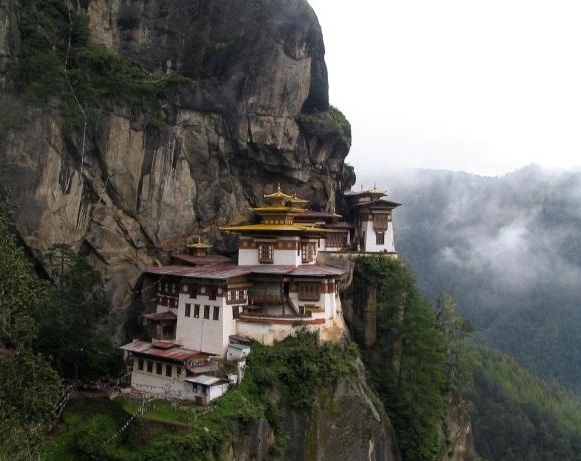
For many, Thanksgiving is a sacred ritual. Families often spend hours in the kitchen preparing elaborate meals and specialty dishes, and some make long pilgrimages across the country to give thanks and congregate around the sacred space that is the dinner table.
Sacred spaces can range from the secular to the more decidedly spiritual. In the Museum’s exhibition Sacred Spaces, we are giving visitors a chance to reflect on everyday devotion and presenting a number of rituals practiced throughout the Himalayan region. Discover more about sacred spaces with our list of eight beautiful and revered locations in the Himalayas:
Mount Kailash

Mount Kailash is a venerated holy place considered sacred in Hinduism, Bon, Buddhism, and Jainism. The site has a different symbolic meaning in each religion. Hindus believe it to be the home of Lord Shiva and the manifestation of heaven. Jains consider it the place where Rishabhadeva, Jainism’s creator, attained freedom from the cycle of life and rebirth. Some Buddhists believe it to be the center of the universe. Because of the mountain’s remote and highly elevated location in western Tibet, it sees only a few thousand pilgrims per year.
Lake Manasarovar

Located at the base of Mount Kailash, Lake Manasarovar is a popular place of pilgrimage for both Buddhists and Hindu believers. It is the highest freshwater lake in the world. Tibetans consider it the most sacred lake in Tibet, its waters being of the highest quality of all the lakes in Tibet. According to Hindu believers a ritual bath and drink of its holy water has the power to clean the sins of a hundred lifetimes.
Jokhang Temple

The Jokhang is the main temple in Lhasa, Tibet, and is considered the ultimate destination for Tibetan pilgrims. Most pilgrims arrive by foot, circumambulate the temple, and, once inside the temple, hum, pray, present offerings, and bow or prostrate before a sacred sculpture of the Buddha.
Boudhanath

This stupa is the largest in Nepal and one of the holiest Tibetan Buddhist monuments outside of Tibet. It’s located just east of Kathmandu and was probably built in the fourteenth century after the Mughal invasions, although its legendary history goes even further back. In addition to being a popular tourist site, it’s an important site of pilgrimage for Tibetan Buddhists and there are many Tibetan monasteries around the stupa.
Nako

The village of Nako in the Himachal Pradesh region of India is home to eight Buddhist temples, the sacred Nako Lake, and a footprint believed to belong to Padmasambhava, a legendary eighth-century Indian Buddhist master. Its picturesque landscape is dotted with architecture that has been preserved for hundreds of years.
Paro Taktsang or “The Tiger’s Nest”

This small monastery on a cliff in Bhutan is one of thirteen monasteries, or “tiger’s lairs,” where the legendary Indian master Padmasambhava (known to Tibetans and the Bhutanese as the Second Buddha) is said to have meditated. As Bhutan’s most iconic landmark and religious site, it attracts countless pilgrims. After a fire destroyed most of the structure, it was rebuilt as an exact replica of the original temple on the same sacred spot.
Lamayuru

Lamayuru is one of the most ancient Buddhist sites in Ladakh, with its five original temples attributed to the great Buddhist translator Rinchen Zangpo in the eleventh or twelfth century. Only one of those temples, the Senge Lkakhang, still exists. The site’s large Drigung Monastery is characteristic of the powerful monasteries influenced by fortress architecture that arose in the seventeenth century. Legend has it that Lamayuru was once the site of a lake that has since dried up, which contributes to the moon-like landscape for which the surrounding area is known.
Milarepa’s Cave

It is believed that Milarepa, one of Tibet’s most famous yogis and Buddhist practitioners, spent several years of his life in this cave in western Tibet. Pilgrims journey to the site with offerings of decorated stones, sweet herbs, and wildflowers, leaving them along the path to the cave.
Where is your sacred space? Share your ideas on social media using #SacredSpaces, or learn more in our exhibition.
Add Your Thoughts
Comments are moderated, and will not appear on this site until the Rubin has approved them.


Incredible.
your day of love may bring the gratitude of others for life.